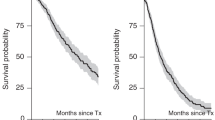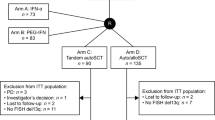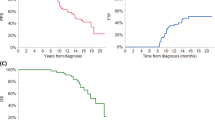Summary:
High-dose therapy with autologous stem cell transplantation (ASCT) has become the treatment of choice for symptomatic eligible patients with multiple myeloma (MM). We report our centre experience and analyse retrospectively the prognostic influence of pretransplant characteristics and transplant modalities on response and survival. A total of 127 MM patients (median age: 55.2 years) were transplanted between 1994 and 2001. In all, 69 patients had IgG, 28 IgA, 23 light chain, one IgD and six non secretory MM. At the time of autograft, 6% of patients were in complete remission (CR), 73% in partial remission (PR), 12% showed minor response to previous treatment and 9% had stable or refractory disease. Prior to autograft, 79% of cases had received only one line of chemotherapy and 21% two or more lines. All patients received PBSC support after conditioning with 200 mg/m2 melphalan alone (100 patients) or melphalan and TBI (27 patients). We evaluated the influence of age (using as cutoff value the ages of 55, 60 and 65 years), type of MM, status pre- and post-ASCT, number of lines of previous regimens, time of ASCT from diagnosis, year of autograft, dose of reinfused CD34+ cells, plasma cell infiltration and β2-microglobulin at diagnosis on overall (OS) and progression-free survivals (PFS) to define patients with better prognosis. Following ASCT, 15% of patients were in CR and 81% in PR, while only two patients progressed. Median OS and PFS from transplantation were 50.4 and 23.5 months, respectively. Median OS from diagnosis was 79.7 months. Transplant-related mortality was 2.3%. Low levels of β2-microglobulin and the achievement of CR post-transplant correlated with longer PFS (P<0.03 and <0.01, respectively). The median PFS was 36.1, 23.9, 21.1 and 16.4 months for nonsecretory, IgG, IgA and light chain subtypes, respectively. Age was not an important prognostic factor at a cutoff value of 55 or 60 years. We conclude that ASCT is a safe and effective procedure even in resistant cases. The outcome was independent of age, time from diagnosis, previous treatment and conditioning regimen, but there was a tendency for better survival in the nonsecretory patients.
This is a preview of subscription content, access via your institution
Access options
Subscribe to this journal
Receive 12 print issues and online access
$259.00 per year
only $21.58 per issue
Buy this article
- Purchase on Springer Link
- Instant access to full article PDF
Prices may be subject to local taxes which are calculated during checkout





Similar content being viewed by others
References
Greenlee RT, Hill-Harmon MB, Murray T, Thun M . Cancer statistics, 2001. CA Cancer J Clin 2001; 51: 15–36.
Boccadoro M, Marmont F, Tribalto M et al. Multiple myeloma: VMCP/VBAP alternating combination chemotherapy is not superior to melphalan and prednisone even in high-risk patients. J Clin Oncol 1992; 10: 334–342.
Myeloma Trialists' Collaborative Group. Combination chemotherapy versus melphalan plus prednisone as treatment for multiple myeloma: an overview of 6663 patients from 27 randomised trials. J Clin Oncol 1998; 16: 3832–3842.
UK Myeloma Forum. British Committee for Standards in Haematology. Diagnosis and management of multiple myeloma. Br J Haematol 2001; 115: 522–540.
Cohen HJ, Bartolucci A . Age and the treatment of multiple myeloma. Southeastern Cancer Study Group experience. Am J Med 1985; 79: 316–324.
Clavio M, Casciaro S, Gatti AM et al. Multiple myeloma in the elderly: clinical features and response to treatment in 113 patients. Haematologica 1996; 81: 238–244.
Riccardi A, Mora O, Brugnatelli S et al. Relevance of age on survival of 341 patients with multiple myeloma treated with conventional chemotherapy: updated results of the MM87 prospective randomised protocol. Cooperative Group of Study and Treatment of Multiple Myeloma. Br J Cancer 1998; 77: 485–491.
Pileri A, Palumbo A, Boccadoro M . Current therapeutic options for multiple myeloma. Haematologica 1996; 81: 291–294.
Quaglino D, Di Leonardo G, Pasqualoni E et al. Therapeutic management of hematological malignancies in elderly patients. Biological and clinical considerations. Part IV: multiple myeloma and Waldenstrom's macroglobulinemia. Aging (Milano) 1998; 10: 5–12.
Attal M, Harousseau JL, Stoppa AM et al. A prospective, randomised trial of autologous bone marrow transplantation and chemotherapy in multiple myeloma. Intergroupe Francais du Myelome. N Engl J Med 1996; 335: 91–97.
Barlogie B, Jagannath S, Desikan KR et al. Total therapy with tandem transplants for newly diagnosed multiple myeloma. Blood 1999; 93: 55–65.
Palumbo A, Triolo S, Argentino C et al. Dose-intensive melphalan with stem cell support (MEL 100) is superior to standard treatment in elderly myeloma patients. Blood 1999; 94: 1248–1253.
Lenhoff S, Hjorth M, Holmberg E et al. Impact on survival of high-dose therapy with autologous stem cell support in patients younger than 60 years with newly diagnosed multiple myeloma: a population-based study. Nordic Myeloma Study Group. Blood 2000; 95: 7–11.
Harousseau JL, Attal M, Divine M et al. Autologous stem cell transplantation after first remission induction treatment in multiple myeloma: a report of the French registry on autologous transplantation in multiple myeloma. Blood 1995; 85: 3077–3085.
Siegel DS, Desikan KR, Mehta J et al. Age is not a prognostic variable with autotransplants for multiple myeloma. Blood 1999; 93: 51–54.
Badros A, Barlogie B, Siegel E et al. Autologous stem cell transplantation in elderly multiple myeloma patients over the age of 70 years. Br J Haematol 2001; 114: 600–607.
Tricot G, Jagannath S, Vesole D et al. Peripheral blood stem cells transplants for multiple myeloma: identification of favourable variables for rapid engraftment in 225 patients. Blood 1995; 85: 588–596.
Gupta D, Bybee A, Cooke F et al. CD34+-selected peripheral blood progenitor cell transplantation in patients with multiple myeloma: tumour cell contamination and outcome. Br J Haematol 1999; 104: 166–177.
Blade J, Samson D, Reece D et al. Criteria for evaluating disease response and progression in patients with multiple myeloma treated by high-dose therapy and haemopoietic stem cell transplantation. Myeloma Subcommittee of the EBMT. Br J Haematol 1998; 102: 1115–1123.
Tribalto M, Amadori S, Cudillo L et al. Autologous peripheral blood stem cell transplantation as first line treatment of multiple myeloma: an Italian Multicenter Study. Haematologica 2000; 85: 52–58.
Dimopoulos MA, Hester J, Huh Y et al. Intensive chemo-therapy with blood progenitor transplantation for primary resistant multiple myeloma. Br J Haematol 1994; 87: 730–734.
Bensinger WI, Rowley SD, Demirer T et al. High-dose therapy followed by autologous hematopoietic stem-cell infusion for patients with multiple myeloma. J Clin Oncol 1996; 14: 1447–1456.
Bjorkstrand BB, Ljungman P, Svensson H et al. Allogeneic bone marrow transplantation versus autologous stem cell transplantation in multiple myeloma: a retrospective case-matched study from the European Group for Blood and Marrow Transplantation. Blood 1996; 88: 4711–4718.
Moreau P, Facon T, Attal M et al. Comparison of 200 mg/m2 melphalan and 8 Gy total body irradiation plus 140 mg/m2 melphalan as conditioning regimens for peripheral blood stem cell transplantation in patients with newly diagnosed multiple myeloma: final analysis of the Intregroupe Francophone du Myelome 9502 randomized trial. Blood 2002; 99: 731–735.
Barlogie B, Jagannath S, Naucke S et al. Long-term follow-up after high-dose therapy for high-risk multiple myeloma. Bone Marrow Transplant 1998; 21: 1101–1107.
Majolino I, Vignetti M, Meloni G et al. Autologous transplantation in multiple myeloma: a GITMO retrospective analysis on 290 patients. Haematologica 1999; 84: 844–852.
Bjorkstrand B . European Group for Blood and Marrow Transplantation Registry studies in multiple myeloma. Semin Hematol 2001; 38: 219–225.
Attal M, Payen C, Facom T et al. Single versus double transplant in myeloma: a randomised trial of the ‘Intergroupe Francais du Myelome’. Bone Marrow Transplant 1998; 21 (Suppl. 1): S206 (abstract).
Alegre A, Diaz-Mediavilla J, San-Miguel J et al. Autologous peripheral blood stem cell transplantation for multiple myeloma: a report of 259 cases from the Spanish Registry. Spanish Registry for Transplant in MM and PETHEMA. Bone Marrow Transplant 1998; 21: 133–140.
Alexanian R, Dimopoulos MA, Hester J et al. Early myeloablative therapy for multiple myeloma. Blood 1994; 84: 4278–4282.
Vesole DH, Jagannath S, Tricot G et al. Autologous bone marrow and peripheral blood stem cell transplantation in multiple myeloma. Cancer Invest 1996; 14: 378–391.
Vesole DH, Crowley JJ, Catchatourian R et al. High-dose melphalan with autotransplantation for refractory multiple myeloma: results of a Southwest Oncology Group phase II trial. J Clin Oncol 1999; 17: 2173–2179.
Tricot G, Spencer T, Sawyer J et al. Predicting long-term (> or =5 years) event-free survival in multiple myeloma patients following planned tandem autotransplants. Br J Haematol 2002; 116: 211–217.
Rajkumar SV, Fonseca R, Dispenzieri A et al. Effect of complete response on outcome following autologous stem cell transplantation for myeloma. Bone Marrow Transplant 2000; 26: 979–983.
Harousseau JL, Attal M, Divine M et al. Autologous stem cell transplantation after first remission induction treatment in multiple myeloma: a report of the French Registry on autologous transplantation in multiple myeloma. Blood 1995; 85: 3077–3085.
Sirohi B, Powles R, Treleaven J et al. The role of autologous transplantation in patients with multiple myeloma aged 65 years and over. Bone Marrow Transplant 2000; 25: 533–539.
Lahuerta JJ, Martinez-Lopez J, Grande C et al. Conditioning regimens in autologous stem cell transplantation for multiple myeloma: a comparative study of efficacy and toxicity from the Spanish registry for transplantation in multiple myeloma. Br J Haematol 2000; 109: 138–147.
Desikan KR, Tricot D, Dhodapkar M et al. Melphalan plus total body irradiation (MEL-TBI) or cyclophosphamide (MEL-CY) as a conditioning regimen with second autotransplant in responding patients with myeloma is inferior compared to historical controls receiving tandem transplants with melphalan alone. Bone Marrow Transplant 2000; 25: 483–487.
Blade J, Kyle RA . Nonsecretory myeloma, immunoglobulin D myeloma, and plasma cell leukaemia. Hematol Oncol Clin North Am 1999; 13: 1259–1272.
Smith DB, Harris M, Gowland et al. Non-secretory multiple myeloma: a report of 13 cases with a review of the literature. Hematol Oncol 1986; 4: 307–313.
Sirohi B, Powles R, Kulkarni S et al. Comparison of new patients with Bence–Jones, IgG and IgA myeloma receiving sequential therapy: the need to regard these immunologic subtypes as separate disease entities with specific prognostic criteria. Bone Marrow Transplant 2001; 28: 29–37.
Fermand JP, Ravaud P, Chevret S et al. High-dose therapy and autologous peripheral blood stem cell transplantation in multiple myeloma: up-front or rescue treatment? Results of a multicenter sequential randomized clinical trial. Blood 1998; 92: 3131–3136.
Acknowledgements
We thank the staff of the Bone Marrow Transplant wards of the Hammersmith Hospital and the referring physicians for their contribution and valuable discussion.
Author information
Authors and Affiliations
Rights and permissions
About this article
Cite this article
Terpos, E., Apperley, J., Samson, D. et al. Autologous stem cell transplantation in multiple myeloma: improved survival in nonsecretory multiple myeloma but lack of influence of age, status at transplant, previous treatment and conditioning regimen. A single-centre experience in 127 patients. Bone Marrow Transplant 31, 163–170 (2003). https://doi.org/10.1038/sj.bmt.1703818
Received:
Accepted:
Published:
Issue Date:
DOI: https://doi.org/10.1038/sj.bmt.1703818
Keywords
This article is cited by
-
Outcome and characteristics of nonsecretory multiple myeloma compared with secretory multiple myeloma: a retrospective multicenter study from China
BMC Cancer (2023)
-
High-dose therapy and autologous stem cell transplant in older adults with multiple myeloma
Bone Marrow Transplantation (2015)
-
Importance of blood graft characteristics in auto-SCT: implications for optimizing mobilization regimens
Bone Marrow Transplantation (2011)
-
High levels of circulating CD34+ cells at autologous stem cell collection are associated with favourable prognosis in multiple myeloma
British Journal of Cancer (2011)
-
Prophylactic intravenous immunoglobulin during autologous haemopoietic stem cell transplantation for multiple myeloma is not associated with reduced infectious complications
Annals of Hematology (2011)



